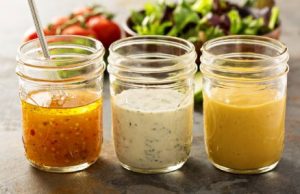
I když je nesmírně těžké popsat základy konkrétní kontinentální kuchyně, existují určité faktory, které dokážou obsáhnout národní potravinářské tradice téměř každé země. The first word that strikes the mind when one thinks of the Asia is – zdravý. Japonsko je všeobecně uznáváno jako země, ve které se lidé dožívají nejdelšího věku. Zbytek světa teprve nyní začíná věnovat větší pozornost zavedeným asijským potravinářským postupům a uplatňuje je ve svých každodenních kuchařských receptech.. Pojďme se podívat na roli různých dresinků a koření v asijské kuchyni.
There are two defining factors in the typical Asian cuisine – love of fish and sea food, a rozšířené používání různých koření a příchutí. Není neobvyklé, že jídlo na tomto kontinentu obsahuje šest nebo více různých chutí. Nejoblíbenější jsou slané, pikantní, bonbón, pikantní, kyselý, hořký, svíravý (taková, která vyvolává pocit svraštění), and let’s not forget about the specific Japanese umami – a brothy (nebo masité) chuť, která dlouho vydrží.
Korejci mají také svou vlastní jedinečnou chuť kimchi. Samotné koření se vyrábí ze sušené a mleté zeleniny a je extrémně pálivé, takže nebuďte příliš štědří, když ho dáváte na jídlo. Indické tradiční jídlo má rádo hodně zázvoru, česnek, šafrán, a garam masala do jejich typických jídel, zatímco Číňané jsou nechvalně známí používáním červeného chilli oleje z oblasti Sichuan.
To, co je všechny spojuje, je láska k detailu, disciplína, stejně jako pro harmonii a rovnováhu. To je také zcela v souladu s jejich zavedenými náboženskými zvyklostmi. I když jídlo může obsahovat více než 10 samostatné přísady, bude to stále hřejivé a chutné.
Tato široká škála chutí a chutí se připisuje skutečnosti, že asijské země mají rozšířené území a jsou odděleny obrovskými délkami moře a pevniny.. Některá koření se přirozeně vyskytují v některých oblastech kontinentu, while others – in more distant ones.
Špatné stravovací návyky Na které byste měli zapomenout
Jak používat dresinky & Koření na asijskou kuchyni
Rovnováha v přípravě jídel
 Asiaté jsou docela organizovaní lidé. Tato jejich vlastnost je poměrně výrazná a jsou za to velmi respektováni. Hlavní rozdíl mezi lidmi ze západního světa a jimi spočívá v tom, že naše národní tradice mají tendenci rozdělovat produkty do různých skupin potravin již při procesu přípravy..
Asiaté jsou docela organizovaní lidé. Tato jejich vlastnost je poměrně výrazná a jsou za to velmi respektováni. Hlavní rozdíl mezi lidmi ze západního světa a jimi spočívá v tom, že naše národní tradice mají tendenci rozdělovat produkty do různých skupin potravin již při procesu přípravy..
Totéž děláme i při podávání jídla. Asijská kuchyně posouvá věci na zcela novou úroveň a přidává nejen směs různých koření, bylinky, a ingredience, ale také mnoho samostatných textur, které se dokážou dokonale propojit.
Vyváženost a přesnost jsou ve skutečnosti klíčovými ingrediencemi asijské kuchyně. Velká pozornost je věnována také tomu, zda je pokrm podáván studený, horký, schnout, vlhký, těžké nebo lehké. To se provádí za účelem zajištění správného trávení po jídle.
Masné výrobky také nejsou tak široce používány. Rýže a zelenina, na druhou stranu, jsou hlavní komponenty. Totéž platí pro dresinky a koření. V Asii, běžně se přidává sezamový olej, rybí omáčka, citrusová šťáva, nebo sójová omáčka do salátových dresinků.
Koření & Dresy v asijské kuchyni
 Dalším určujícím momentem pro tradiční asijskou kuchyni je jejich láska k různým kořením a bylinkám. Koření a dresinky se také hojně používají k tomu, aby nejen zvýraznily chuť daného jídla, ale také usnadnily tělu odbourat jednotlivé složky a nemusely procházet žádnými únavnými bolestmi žaludku nebo potížemi..
Dalším určujícím momentem pro tradiční asijskou kuchyni je jejich láska k různým kořením a bylinkám. Koření a dresinky se také hojně používají k tomu, aby nejen zvýraznily chuť daného jídla, ale také usnadnily tělu odbourat jednotlivé složky a nemusely procházet žádnými únavnými bolestmi žaludku nebo potížemi..
Mají zvláštní zálibu v koření. Uvedené mohou být sambaly, chutney, a dals. Dalším typickým znakem je, že není neobvyklé, že jsou vyrobeny z chilli papriček, Ryba, tamarind, česnek nebo jiné listové koření.
Většina koření a dresinků může být docela pálivá. Nejznámější jsou rybí omáčka, sezamový olej, jsem vrba, Sriracha, chilli česneková omáčka, a sambal trassi.
Protože většina různých směsí koření se nepěstuje v jedné a té samé oblasti, kromě kari, jednotlivé části kontinentu mají své vlastní jedinečné styly.
Široká škála směsí koření
Eastern Asia is infamous for its regular use of these spice blends – Japanese Seven Spice, Směs Teriyaki, Směs omáček Hoisin, Fermentované fazolové koření, zatímco jižní Asie se zaměřuje spíše na ty, které zahrnují kari. Také rádi přidávají do jídla několik vrstev, což znamená, že se často kombinuje s kokosovým ovocem nebo olejem.
Návštěva jihovýchodní části Asie znamená, že dresink a koření budou extrémně pálivé a pikantní. Obvykle mají silnou vůni, díky které jsou jídla dokonalou směsí mezi pikantním a sladkým.
Asijské dresinky & Seasonings – Hot but Delicious
 Ne každý má rád pálivá jídla. Ale jedna z věcí, díky kterým jsou jídla ochucená horkými dresinky nebo omáčkami tak zdravá, je skutečnost, že mají schopnost zabíjet bakterie a chránit před parazitárními infekcemi..
Ne každý má rád pálivá jídla. Ale jedna z věcí, díky kterým jsou jídla ochucená horkými dresinky nebo omáčkami tak zdravá, je skutečnost, že mají schopnost zabíjet bakterie a chránit před parazitárními infekcemi..
Asijská kuchyně a její specifické vlastnosti nejsou lžičkou pro každého, ale rozhodně stojí za vyzkoušení.


